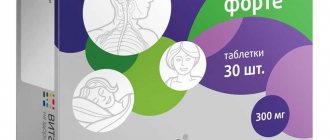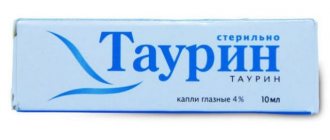Glycine is a drug used to reduce emotional arousal, relieve stress, and improve mental and physical performance.
Belongs to the group of psychostimulant and neotropic drugs. Positively affects memory processes. It has a calming effect, helps improve sleep and eliminates anxiety.
On this page you will find all the information about Glycine: complete instructions for use for this drug, average prices in pharmacies, complete and incomplete analogues of the drug, as well as reviews of people who have already used Glycine. Would you like to leave your opinion? Please write in the comments.
Pharmacological effect
The use of Glycine, according to reviews, promotes:
- Improving social adaptation and mood;
- Increasing mental performance;
- Facilitate falling asleep and normalize sleep;
- Reducing psycho-emotional stress, aggressiveness and conflict;
- Reducing the toxic effects of ethanol on the central nervous system;
- Reducing the severity of vegetative-vascular disorders, including conditions characteristic of menopause and cerebral disorders against the background of ischemic stroke and traumatic brain injury.
The active substance Glycine is a non-essential amino acid that has a sedative and antidepressant effect and helps improve metabolic processes in brain tissue. According to the instructions, glycine easily and quickly penetrates most body tissues and biological fluids, including the brain, subsequently decomposing in the liver.
What is Glycine used for?
Let's figure out what glycine is needed for and why is it prescribed to adults or children? Here are the main indications for use:
- sleep disorders;
- poor concentration;
- alcoholism and hangover syndrome;
- irritability, anxiety, excessive excitability;
- rehabilitation period after operations;
- recovery period after traumatic brain injury;
- neurological disorders;
- stressful situations, increased psycho-emotional stress;
- exhaustion of the body;
- decreased level of performance;
- increased fatigue;
- deterioration in memory function;
- blurred vision;
- vegetative-vascular dystonia;
- encephalopathy, epilepsy;
- unstable blood pressure.
According to the latest data, the drug helps with problems with excess production of gastric juice, with increased blood acidity, and also has a beneficial effect in the treatment of muscular dystrophy and has a positive effect on the functioning of the pituitary gland.
Use during pregnancy and lactation
When breastfeeding, it is allowed to take this drug, since it has a gentle effect on the body, and small doses of the active substance enter the baby’s body with mother’s milk. Only a specialist can determine the dosage.
During early pregnancy, as well as in the 2nd and 3rd trimester, tablets are used for a variety of nervous system disorders. Whether pregnant women can take Glycine depends on the woman’s health. During pregnancy, the permissible dose of the drug must be determined only individually.
The instructions for the drug indicate that there is no clear information about the safety of the drug for pregnant women. But experts warn that pregnant women should treat this drug with caution and take into account contraindications and possible side effects.
Storage conditions
Glycine is a prescription sedative. The shelf life of the tablets is 36 months if they are stored in compliance with the storage conditions recommended by the instructions (at temperatures up to 25 ° C).
Store in a dry, dark place, out of reach of children, at temperatures up to 25 °C.
Shelf life – 3 years.
Available without a prescription.
The average price for Glycine in pharmacy chains is 25–40 rubles (the package includes 50 tablets).
Instructions for use
The instructions for use indicate that Glycine is administered sublingually or buccally at 100 mg (in tablets or in powder form after crushing the tablets).
- For sleep disorders, Glycine is prescribed 20 minutes before bedtime or immediately before bedtime, 0.5-1 tablet. (depending on age).
- For practically healthy children, adolescents and adults with psycho-emotional stress, decreased memory, attention, mental performance, mental retardation, and deviant forms of behavior, Glycine is prescribed 1 tablet. 2-3 times/day for 14-30 days.
- For ischemic cerebral stroke: during the first 3-6 hours from the onset of stroke, 1000 mg is prescribed buccally or sublingually with one teaspoon of water, then for 1-5 days 1000 mg/day, then over the next 30 days 1-2 tablets . 3 times/day.
- For functional and organic lesions of the nervous system, accompanied by increased excitability, emotional lability and sleep disturbances, children under three years of age are prescribed 0.5 tablet. (50 mg) per dose 2-3 times/day for 7-14 days, then 50 mg 1 time/day for 7-10 days. Daily dose – 100-150 mg, course dose – 2000-2600 mg. Children over 3 years of age and adults are prescribed 1 tablet. 2-3 times/day, course of treatment is 7-14 days. The course of treatment can be increased to 30 days; if necessary, the course is repeated after 30 days.
In narcology, Glycine is used as a means of increasing mental performance and reducing psycho-emotional stress during the period of remission in cases of encephalopathy, organic lesions of the central and peripheral nervous system, 1 tablet. 2-3 times/day for 14-30 days. If necessary, courses are repeated 4-6 times a year.
Analogs
Each tablet contains 100 mg of the active ingredient - glycine, as well as 1 mg of methylcellulose and 1 mg of magnesium stearate.
Glycine is contained in the tablet in the form of microcapsules - glycine molecules in a methylcellulose shell. Microencapsulated glycine is produced using patented technology at MNPK BIOTIKI LLC. The drug is available in tablets that must be kept under the tongue until completely dissolved. This method of administration is called sublingual. If this cannot be done, you can place the tablet behind the cheek - this is a buccal method of administration.
Now many manufacturers produce both glycine in its pure form and in combination with vitamins or herbal ingredients. The first glycine producer in Russia is the Medical Research and Production Complex “BIOTICS”. Here, a unique technology for the production of the amino acid glycine in the form of microcapsules was created and patented.
The drug is produced in the form of sublingual tablets: flat-cylindrical, white with marbling elements, with a bevel (50 pcs. in blister packs, 1 pack in a cardboard box).
1 tablet contains:
- Active substance: microencapsulated glycine – 100 mg;
- Auxiliary components: magnesium stearate – 1 mg; water-soluble methylcellulose – 1 mg.
Analogs of Glycine are: Glycine Forte, Glycine-Bio Pharmaplant, Glycine-Canon, Glycine-MHPP, Glycised, Tenoten, Memsidol, Parkon, Phenibut, Enerion.
Glycine also has analogues, but it is still the same drug with different names - Glycine Forte Evalar (300 and 600 mg tablets), Glycine-Canon (1000 mg tablets), Glycine-Bio, Glycine Active, Glycine-Vis (capsules 300 mg). Glycine Forte Evalar and Glycine-Vis also contain B vitamins, which are designed to enhance the beneficial effect of the amino acid on nervous activity. In addition, these products, like Glycine Active, are not medicines, but dietary supplements.
Indirect analogs of glycine can also include other nootropic drugs, such as tryptophan, phenotropil, piracetam, glutamic acid, mexidol, etc. However, their mechanism of action is somewhat different and in most cases they will not be able to replace glycine.
The main form of glycine production is sublingual tablets or capsules. 1 tablet contains 100 mg of active substance. The tablets must be placed under the tongue until completely absorbed. This is how the amino acid quickly enters the bloodstream and spreads throughout the tissues of the body.
The tablets contain pure aminoacetic acid, auxiliary components (magnesium stearate, water-soluble methylcellulose). Depending on the pathology, the doctor determines the dosage of the drug. You can read in detail about all the nuances of taking it for various diseases in the article: “Correct instructions for use are the key to success when taking glycine!”
Capsules with the substance
Capsules containing the amino acid do not dissolve, but are taken orally on an empty stomach. They must be washed down with water. Capsules contain much more acid than tablets - 3000 mg, so oral administration is the optimal method of consumption.
Powder form
The acid is produced in powder form, this preparation is called “Glycine MS”. The powder product contains both the main substance - aminoacetic acid, and auxiliary components: l-carnitine, vitamin B1. The powder is placed under the tongue until completely absorbed.
In addition, you can prepare glycine powder yourself. This is relevant when the drug is needed by a small child. Because the baby needs a pure substance, without vitamins and other additives. Tablets of the drug are ground to a powder consistency, mixed with water, and given to the baby in the form of drops.
Liquid form
In liquid form, the substance contains nootropic drugs that are used for injections. The amino acid is contained in Cortexin ampoules - vials. Here glycine plays the role of a stabilizing element. The substances complement and enhance each other’s effects.
The antioxidant, metabolic, and restorative properties of aminoacetic acid allow it to be used in cosmetics. The substance is not included in ointments, but is actively used in the manufacture of serums and creams.
Cosmetic products containing amino acids perfectly moisturize, rejuvenate the skin, and have a regenerating, antioxidant effect on the epidermis. In addition, aminoacetic acid allows other beneficial substances of the cream or serum to penetrate deeply into the layers of the skin.
Glycine is an effective remedy to prevent and stop the development of many diseases. The 100% natural composition allows the drug to be used by pregnant, lactating women, children, the elderly, and teenagers. Taking the substance will allow you to completely get rid of stress, depression, live a full life as a happy person and enjoy every day!
The drug Glycine is produced in the form of sublingual tablets, each containing 100 mg of the active substance of the same name and methylcellulose as an additional component.
Based on the active substance, a number of analogues of Glycine are produced. In addition, if there is hypersensitivity to Glycine, after consultation with a doctor, it is possible to use one of the analogues of the medication that has a similar therapeutic effect: Lucetam, Bravinton, Acephen, Vinpocetine, Amylonosar, Vincetin, Phezam, Cortexin, Ginkoum, Demanol, Picanoil, Carnicetine, Idebenone , Cavinton, Memotropil, Telektol, Ceraxon, Minisem, Noopept, Noben, Nootropil, Omaron, Pantogam, Piracetam, Semax, Epithalamin, Korsavin, Thiocetam, Lucetam.
Instructions for use of glycine for children
The drug has a sweet taste, so children usually enjoy swallowing the tablets. If it is impossible to dissolve the tablet (newborns, early childhood), it is permissible to grind the required amount of the drug into powder and dilute it in a teaspoon of water.
- For children over 3 years of age, the drug is prescribed in the adult dosage: 1 tablet (100 mg) twice or thrice a day for 1-2 weeks, with a maximum increase in the course to 4 weeks.
- Children under three years old: 0.5 tablet. (50 mg) of glycine taken twice or thrice a day for 7-14 days, then 50 mg once a day for 7-10 days. The daily dose for children under 3 years of age is 100-150 mg of glycine, and the course dose is no more than 2000-2600 mg.
Description
Chemical formula of glycine
Often the body's own production of glycine does not meet the brain's needs. This is especially true during illness or stress. To cope with these loads, you can take the drug Glycine - it will help the body better cope with the synthesis of this amino acid.
Glycine is available in tablet form. Recommended method of use is dissolution under the tongue. Glycine has a sweetish taste (hence its name - “glycis” means “sweet” in Greek), and therefore children take it with pleasure. There is no need to take the tablet with water. The effectiveness of glycine does not depend on food intake. The shelf life when stored at a temperature not exceeding 25 ºС is 3 years.
Compound
The composition of the drug, in addition to the amino acid itself, includes excipients: 1 mg of methylcellulose, 1 mg of magnesium stearate. The mass of the active substance is 100 mg.
Glycine preparations are also produced, which contain B vitamins - B1, B6 and B12, as well as tablets with a different dosage.
Overdose
As indicated in the instructions for use of the drug Glycine in adults and children, the body becomes less susceptible to its action as a result of systematically exceeding the dose of the drug.
Among the main symptoms of overdose are:
- memory impairment;
- pain in the right side;
- nausea;
- depression;
- lethargy, poor coordination;
- general lethargy;
- stomach pain.
If any symptom appears, you should stop taking the drug and consult a doctor.
Reviews
We have selected some people's reviews about the drug Glycine:
- Margarita. The pediatrician prescribed glycine to my daughter at the time when she started attending kindergarten. The baby had a hard time adapting, was capricious, restless and whiny. After two weeks of using the drug, improvements became noticeable. My daughter became much calmer, whims and hysterics happened less and less often, her sleep improved, and her increased anxiety disappeared. The tablets were supposed to be dissolved under the tongue, but I was afraid that the child was small and might choke, so I simply dissolved the tablet in a teaspoon of water. The drug has a slightly sweet taste, so it does not cause disgust and my daughter took it without objection.
- Karina. To relieve stress, I often resort to a remedy such as Glycine. The drug costs a penny and is sold at any pharmacy. It has no contraindications and, unlike sedatives, does not cause drowsiness, which is very important for me, since I am constantly driving. Glycine helps to calm down, relieves nervous tension, while the mind remains clear and the reaction speed does not slow down. An important advantage of Glycine is the absence of side effects and negative effects on the body.
- Nastya. When buying from pharmacies, look at what they sell you, now there are so many scammers in pharmacies, they need to sell dietary supplements, but Glycine is available with additives. For example Glycine Gly600 mg. pure dietary supplement, yesterday at the Gorzdrav pharmacy I asked for Glycine, they sold me this one, I was without glasses, the pharmacist said it was regular Glycine only in a different package. I come home and it says Bad. At the Gorzdrav pharmacy they often lie about dietary supplements; pharmacists tell us we need to sell them, be careful. Ask for plain Glycine without additives.
Those who have given Glycine to children note that positive results are noticeable after some time. However, some parents testify that they never received a positive effect. Reviews from doctors about Glycine are mostly positive. The drug is considered relatively harmless, so it is prescribed even to newborns to relieve hypertension and anxiety. As a negative, some patients noted the manifestation of allergies, as well as the body’s rejection of Glycine.
Glycine. Reviews from doctors and patients.
Now there are numerous reviews about Glycine, which is often prescribed to older children and even newborns. Many patients claim that they often undergo treatment with the drug because it helps normalize sleep and reduce stress. It also has virtually no contraindications and is affordable.
Parents claim that the use of Glycine in children gives very good results soon after the start of therapy. However, there are also reports of the drug being ineffective. Doctors speak positively about the drug, claiming that it is absolutely harmless and can be used even in infants to combat hypertension and anxiety.
Many years of practice in using Glycine have allowed us to accumulate a lot of practical material for studying its effectiveness. Doctors regularly prescribe Glycine to adults and children, as it is a safe and universal drug that allows you to gradually restore normal processes in the body naturally.
Glycine fits well into treatment regimens for neurological diseases, heart and vascular diseases, digestive problems, chronic allergic diseases of the lungs and bronchi, and skin diseases. The drug is recommended as a preventive and general strengthening agent.







